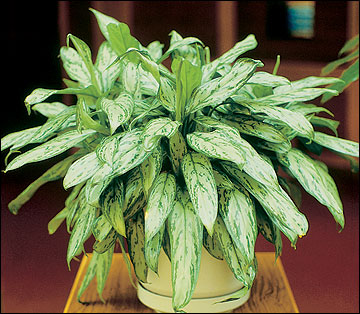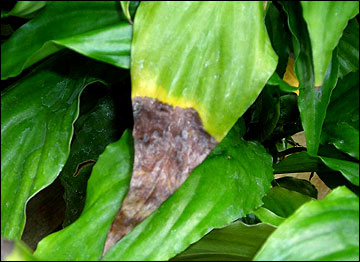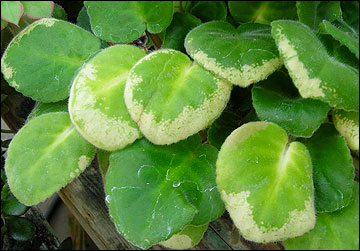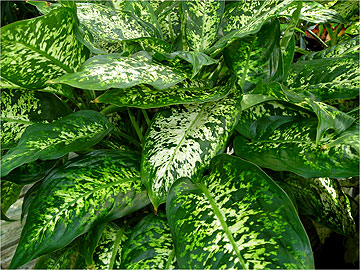To many people, a home is not complete without attractive potted plants. Proper care of houseplants helps increase satisfaction and enjoyment from them and extends the blooming period of many flowering plants.
Most potted plants purchased from a florist have been grown in greenhouses under ideal conditions. When they are placed in home environments designed for people, not plants, they need good care to adjust to the new environment.
Watering
Houseplants are probably killed or injured more often by improper watering than by any other single factor. No general schedule can be used for watering all houseplants. Size of plant, pot, light, temperature, humidity and other conditions influence the speed with which the soil mass dries out.
When to water
In general, flowering plants need more water than foliage plants of the same size. Never water any plant unless it needs it. Soil kept either too wet or too dry causes plant roots to die, which leads to poor growth or death of the plant. Never allow plants to wilt, and never allow them to stand in water for long periods of time.
Learn to gauge the moisture content of the soil by its color and feel. As the soil surface dries, it becomes lighter. Under continued drying, the soil begins to crack and pull away from the sides of the pot. When severe drying occurs, some damage already will have been done to the roots. Soil kept too moist becomes sticky and slimy, thus inviting root rots and other disease problems.
Kinds of water
Ordinary tap or well water is usually satisfactory for plants. Chlorine and fluorine often added to city water do not harm plants. Rainwater and melted snow are excellent water sources. Water run through most water softeners, however, should not be used continuously for watering potted plants.
How to water
Plants may be watered from either the top or the bottom of the pot. If you prefer watering from the top, use a watering can with a small spout and keep as much water off the foliage as possible. Each time, wet the entire soil mass, not just the top inch. Add water until it comes through the drainage hole in the bottom of the pot. Discard water that remains beneath the pot one hour after watering.
Watering from the bottom ensures thorough wetting of the soil mass. Place the pot in a pan or saucer filled with water, or dunk the pot to just below its rim in a deep bucket of water. When the top of the soil becomes moist, the entire soil ball should be wet. Remove the pot, allow it to drain, and return it to the saucer.
Salts may form a white accumulation on the soil surface if plants are watered regularly from the bottom. Occasional watering from the top helps wash out the salts. Don’t allow the soil to reabsorb any water that has been run through the soil to leach out salts. If surface salt accumulation becomes too heavy to remove in this way, scrape off the surface soil and replace it with fresh soil. Try not to injure plant roots.
Drainage
Potted plants should always have good drainage. Occasionally, the drainage hole may become clogged by roots. Check it by pushing a finger, stick or pencil into it. Even if drainage from the pot is good, pot coverings can hold water. Pots wrapped in waterproof foil or placed in deep planters should be checked occasionally for standing water.
Plants with “wet feet” soon look sick — leaves yellow or drop, flowers collapse, and normally healthy white roots turn brown. Any or all of these symptoms can result from stagnation of the water, too little soil oxygen and development of diseases that rot the roots.
Lighting
Improper light intensity ranks close to improper watering as a frequent cause for failure with houseplants. A plant in proper light is better able to withstand the high temperature and low humidity of many homes. The amount of light necessary for good growth varies with different types of plants (Figure 1).
 Figure 1
Figure 1
Chinese evergreen is one of many foliage plants adapted to conditions in the home.
Flowering plants
All flowering plants need moderately bright light. Plants kept continuously in poor light will have spindly shoots, few flowers, yellow foliage, poor flower color and, often, little or no growth.
South, east or west windows are excellent for most flowering potted plants, with the possible exception of African violets and related plants, which prefer a north window. Plants in bloom should be kept out of direct sunlight or the flowers will heat excessively and collapse more quickly.
Light in the average room, away from windows, is not bright enough for most flowering plants, even when ceiling fixtures are kept on.
Fluorescent lights located fairly close to houseplants will improve growth of plants that cannot be placed close to windows. When using artificial lights, place them about one foot above the top of the plant and keep them on for about 16 hours each day. The effects of insufficient light cannot be cured by extra fertilizer, water or repotting.
Foliage plants
Foliage plants are generally divided into those suitable for low-light areas, moderate-light areas and bright-light areas. Only a few plants can tolerate dimly lit room interiors. Most foliage plants do well with light at a north window, daylight with no direct sun, or sunlight diffused through a lightweight curtain. Plants that require full sunlight should be put in a south window.
Plants can become acclimated to a location. An abrupt move from a low-light to a bright-light location may be damaging. Leaves gradually face toward light for maximum light absorption, especially in low-light areas. Moving a plant disrupts this orientation and causes the plant to use light less efficiently for a period of time. This is especially true of large plants.
Abruptly moving a plant to more intense light — especially direct sunlight — results in bleaching or burning of foliage. Any lighting changes should be made gradually. Many plants can be kept from getting one-sided by turning them once a week.
Temperature
Proper temperatures for plants are often hard to find in the house. A hot, dry atmosphere shortens the life of flowers. Flowering potted plants do best in temperatures of 65 to 75 degrees F during the day and 55 to 60 degrees F at night. To extend the bloom of flowering potted plants in the home, move them to a cool spot at night.
Foliage plants are more tolerant of high temperatures, but they thrive at temperatures between 65 and 70 degrees F.
In winter, the temperature near windows may be cooler than elsewhere in the house. If drapes are drawn around a plant placed near a window, the temperature may be too cool. On cold nights, check temperatures close to windows. Some tropical foliage plants can be injured by temperatures below 40 degrees F.
Do not put plants at windows that have hot air registers or radiators directly below them. Hot air blowing on a plant often causes leaves to brown on the edges and, occasionally, to drop or die.
Humidity
Air in most modern homes is extremely dry during the winter. A furnace or room humidifier can help plant growth. If a humidifier cannot be used, watertight trays placed beneath the plants and filled with constantly moist sand or gravel help increase humidity around the plants. Pots must be placed on, not in, the wet sand or gravel.
Misting over the leaves daily can help a plant overcome the stress of low humidity. Plants needing constant high humidity, such as orchids or gardenias, are best kept in kitchens or bathrooms, where humidity often runs higher. A relative humidity between 40 and 60 percent is best for most plants but is difficult to attain indoors.
Fertilizing
Newly purchased plants have been well fertilized in the greenhouse. They seldom need additional fertilizer for a few weeks. Plants that will be discarded after flowering will not benefit from being fertilized. Plants that will be kept should be put on a regular fertilization program.
When to fertilize
Fertilizing once a month is adequate for most houseplants that are producing new growth or flowers. However, plants do not need fertilizer in winter when no new growth is apparent.
Do not use fertilizer to stimulate new growth on a plant located in poor growing conditions. Lack of growth is more often due to improper light or watering than to nutritional deficiencies. In such cases, adding fertilizer may actually cause additional injury.
Drop of lower leaves, overall yellow-green color or weak growth may indicate a need for fertilization. However, these same symptoms may result from poor light or overwatering, so evaluate all conditions before fertilizing more than normal.
Kinds of fertilizers
Water-soluble, complete fertilizers formulated for houseplants are available from many garden shops, florists and nurseries. They are easy to use. Formulations vary, so be sure to follow directions carefully. Do not apply more than directed. The roots of potted plants are quite restricted and easily burned by the application of too much fertilizer at one time.
Never apply liquid fertilizers to a wilted plant. Water the plant first, and apply fertilizer after the plant has recovered and the soil has dried slightly.
Soluble fertilizers such as 20-20-20 may also be used for fertilizing houseplants. Make a solution by mixing 1-1/2 teaspoons of this material in 1 gallon of water.
Some people prefer to use organic fertilizers for houseplants, but either an organic or inorganic fertilizer or a combination of both will be a satisfactory source of nutrients.
Fertilizers that release nutrients slowly or over a long time period require less frequent application than liquid forms. They are available in beads, pills, spikes and other forms. Never exceed amounts suggested by the manufacturer’s directions.
Repotting
Plants just brought home from the greenhouse seldom need immediate repotting. Many will not require potting for some time. A newly acquired plant must make adjustments to its new environment, and repotting immediately puts added strain on the plant.
A time for repotting is when the plant becomes pot-bound, this is, when the plant’s roots are too extensive for its pot. A pot-bound plant may need to be watered too frequently and may grow poorly.
A good potting mixture for most houseplants consists of a blend of three parts sphagnum peat, one part vermiculite and one part perlite. Many commercially available peat-lite mixes are ideal for houseplants. Exceptions are epiphytic orchids, which should be potted in a very porous medium such as orchid bark, and cacti, which should be potted in equal parts of peat-lite mix and sterile sand. In most cases, avoid the addition of soil to a potting medium, as this often leads to poor drainage, overwatering and root diseases.
Acid-loving plants such as azaleas and gardenias should have at least 50 percent peat moss or other organic material in the soil mixture. With good care, these plants can be grown successfully in peat moss with no soil added.
To avoid contamination by insects, diseases and weed seeds, sterilize soil mixes before using them. One sterilization method is to moisten the soil, cover it with aluminum foil to keep it from drying out while being heated, and place it in a 200-degree F oven for about 30 minutes or until it is heated through. Chemicals for soil sterilization can also be purchased.
When repotting, avoid excessive damage to the root system. Firm the soil gently around the root ball, but do not press so hard that the soil becomes compacted.
Allow enough space at the top of the pot so that water can be added easily. Water newly potted plants thoroughly, drain, and do not water again until necessary.
Insects and diseases
Watch new plants carefully for development of insect or disease problems. If detected early, these problems often can be corrected easily before serious damage is done. If undetected or ignored, they may become difficult to control. The three most common and difficult houseplant pests are spider mites, scales and mealy bugs. Figures 2, 3 and 4 describe other problems commonly associated with certain species of houseplants.
 Figure 2
Figure 2
Brown leaf tips is a typical symptom of fluoride toxicity, a physiological disorder common in members of the lily family such as Spathiphyllum.
 Figure 3
Figure 3
Plants such as Saintpaulia can suffer chill injury when their leaf temperature fluctuates suddenly. Keep such plants away from cold drafts and use water that is room temperature when watering.
 Figure 4
Figure 4
Some interior plants such as Dieffenbachia contain calcium oxalate, which is a known toxin. Take special precautions when using these plants in homes with children.
Summer care
During the summer, many houseplants can be revitalized if placed outdoors. Do not rush the plants outside too early in the spring. Late May is usually soon enough. Cool nights may injure some plants.
First, place the plants in a sheltered spot on a porch, beneath a tree or behind shrubs close to the house on a mild day, preferably when the weather is cloudy. After about one week of this adjustment, they may be moved to a more exposed but sheltered spot for the rest of the summer.
Plants with large leaves should be placed where they are protected from the wind because their leaves are easily torn.
Potted plants dry rapidly outdoors. Submerging the pots in soil can reduce watering frequency, as well as keep the pots from falling over. Lift each pot occasionally to keep roots from growing out of its drainage hole and to prevent the plant from becoming established outdoors. Fertilize monthly, and check occasionally for insects or diseases that may attack the plants outdoors. Move plants indoors by mid-September before cool weather returns.
Durable houseplants
Although all houseplants grow best with good care, a few tolerate abuse better than others. Some of the most durable houseplants are:
- Snake plant (Sansevieria trifaciata)
- Heart-leaf philodendron (Philodendron scandens)
- Golden pothos (Epipremnum aureum)
- Corn plant (Dracaena fragrans)
- Janet Craig dracaena (Dracaena deremensis)
- Baby rubber plant (Peperomia obtusifolia)
- Cast iron plant (Aspidistra elatior)
- Parlor palm (Chamaedorea elegans)
- Chinese evergreen (Aglaonema modestum)
- Spider plant (Chlorophytum comosum)
Diagnosing cultural problems
Problems resulting from poor growing conditions in the home are difficult to diagnose. Often poor growth results from a combination of several unfavorable factors. See Table 1 for the most favorable cultural conditions for various common houseplants. The following list describes symptoms and causes of several cultural problems.
Lower leaves turn yellow and drop when touched
- Usually caused by overwatering
- May occur when a new plant is moved from a greenhouse to a low-light, low-humidity environment
Yellowing and dropping of leaves at various levels on a plant
- Overwatering
- Poor drainage
- Tight soil
- Chilling
- Gas fumes
Tips or margins of leaves appear burned, brown or both
- Too much fertilizer
- Plant too dry for a short period of time
- Plant exposed to too low temperature for short period
Use of softened water
- New leaves are small
- Soil too dry for long periods
- Poorly drained soil
- Tight soil mixture
New leaves with long internodes
- Not enough light
- Temperature too high
Leaves yellow or light green, weak growth
- Too much light
- Poor root system — possibly from poor drainage, overwatering or tight soil
Cultural preferences of plants often grown in the home
African violet, Saintpaulia
- 65 degrees at night
- Filtered light
- Evenly moist
- Easy to maintain
Amaryllis
- 55 degrees at night
- Bright light
- Evenly moist
- Moderately easy to maintain
Aluminum plant (related pileas)
- 65 degrees at night
- Filtered light
- Evenly moist
- Easy to maintain
Arrowhead, Nephthytis
- 65 degrees at night
- Filtered light
- Evenly moist
- Easy to maintain
Asparagus fern, Plumosus
- 50 degrees at night
- Filtered light
- Evenly moist
- Easy to maintain
Australian tree fern
- 65 degrees at night
- Filtered light
- Thoroughly wet
- Challenging to maintain
Begonia (many types)
- 65 degrees at night
- Filtered light
- Evenly moist
- Moderately easy to maintain
Bromeliads
- 65 degrees at night
- Filtered light
- Evenly moist
- Moderately easy to maintain
Burn plant, Aloe
- 55 degrees at night
- Bright light
- Drench, then dry
- Easy to maintain
Cactus (desert types)
- 65 degrees at night
- Bright light
- Drench, then dry
- Easy to maintain
Cast iron plant, Aspidistra
- 50 degrees at night
- No direct sun
- Evenly moist
- Easy to maintain
Chinese evergreen, Aglaonema
- 65 degrees at night
- No direct sun
- Evenly moist
- Easy to maintain
Coral berry
- 65 degrees at night
- Filtered light
- Evenly moist
- Moderately easy to maintain
Croton
- 65 degrees at night
- Bright light
- Evenly moist
- Moderately easy to maintain
Cyclamen
- 50 degrees at night
- Filtered light
- Evenly moist
- Moderately easy to maintain
Cymbidium orchid
- 55 degrees at night
- Filtered to bright light
- Evenly moist
- Moderately easy to maintain
Dieffenbachia, Dumb cane
- 65 degrees at night
- Filtered light
- Drench, then dry
- Moderately easy to maintain
Dracaena, Corn plant, Ti plant (related types)
- 65 degrees at night
- Filtered light
- Evenly moist
- Easy to maintain
Dwarf orange, other citrus
- 55 degrees at night
- Bright light
- Drench, then dry
- Challenging to maintain
Dwarf schefflera
- 65 degrees at night
- Bright light
- Evenly moist
- Moderately easy to maintain
English ivy, Hedera
- 50 degrees at night
- Bright light
- Evenly moist
- Moderately easy to maintain
Episcia, flame flower
- 65 degrees at night
- Filtered light
- Evenly moist
- Moderately easy to maintain
Ferns (many types)
- 55 degrees at night
- Filtered light
- Evenly moist
- Moderately easy to maintain
Fiddleleaf fig
- 65 degrees at night
- Filtered light
- Evenly moist
- Moderately easy to maintain
Fuschia, Lady's eardrops
- 55 degrees at night
- No direct sun
- Evenly moist
- Moderately easy to maintain
Gardenia
- 65 degrees at night
- Bright light
- Evenly moist
- Challenging to maintain
German ivy
- 60 degrees at night
- Filtered to bright light
- Drench, then dry
- Moderately easy to maintain
Gloxinia
- 65 degrees at night
- Filtered light
- Evenly moist
- Moderately easy to maintain
Hibiscus
- 65 degrees at night
- Bright light
- Evenly moist
- Moderately easy to maintain
Holiday cactus
- 65 degrees at night
- Filtered light
- Evenly moist
- Moderately easy to maintain
Hydrangea
- 55 degrees at night
- Bright light
- Thoroughly wet,
- Moderately easy to maintain
Jade plant, Crassula
- 65 degrees at night
- Bright light
- Drench, then dry
- Moderately easy to maintain
Kalanchoe
- 55 degrees at night
- Bright light
- Drench, then dry
- Moderately easy to maintain
Maidenhair fern, Adiantum
- 65 degrees at night
- No direct sun
- Thoroughly wet
- Moderately easy to maintain
Moses-in-the-cradle, Rhoeo
- 55 degrees at night
- Filtered light
- Evenly moist
- Moderately easy to maintain
Norfolk Island pine
- 55 degrees at night
- Filtered light
- Evenly moist
- Moderately easy to maintain
Orchid (Cattleya types)
- 55 degrees at night
- Filtered light
- Drench, then dry
- Moderately easy to maintain
Palms
- 65 degrees at night
- No direct sun
- Evenly moist
- Moderately easy to maintain
Peace lily, Spathiphyllum
- 65 degrees at night
- Filtered light
- Evenly moist
- Moderately easy to maintain
Peperomia, pepper face
- 65 degrees at night
- Filtered light
- Drench, then dry
- Easy to maintain
Philodendron (many types)
- 65 degrees at night
- Filtered light
- Evenly moist
- Easy to maintain
Poinsettia
- 65 degrees at night
- Bright light
- Drench, then dry
- Moderately easy to maintain
Podocarpus
- 65 degrees at night
- Filtered light
- Evenly moist
- Moderately easy to maintain
Ponytail palm
- 65 degrees at night
- Filtered to bright light
- Evenly moist
- Moderately easy to maintain
Pothos, devil's ivy
- 65 degrees at night
- Filtered light
- Drench, then dry
- Easy to maintain
Prayer plant, Maranta
- 65 degrees at night
- Filtered light
- Evenly moist
- Moderately easy to maintain
Rubber plant, Ficus
- 65 degrees at night
- Filtered light
- Evenly moist
- Moderately easy to maintain
Sago palm, Cycad
- 55 degrees at night
- Filtered light
- Drench, then dry
- Moderately easy to maintain
Schefflera, Umbrella tree
- 65 degrees at night
- Bright light
- Drench, then dry
- Moderately easy to maintain
Sedums
- 55 degrees at night
- Bright light
- Drench, then dry
- Moderately easy to maintain
Shrimp plant
- 55 degrees at night
- Bright light
- Drench, then dry
- Moderately easy to maintain
Snake plant, Sansevieria
- 65 degrees at night
- Filtered to bright light
- Drench, then dry
- Easy to maintain
Spider plant, Chlorophytum
- 50 degrees at night
- Filtered light
- Evenly moist
- Easy to maintain
Spineless yucca
- 65 degrees at night
- Bright light
- Evenly moist
- Moderately easy to maintain
Split-leaf philodendron
- 65 degrees at night
- Filtered light
- Evenly moist
- Moderately easy to maintain
Swedish ivy
- 65 degrees at night
- Filtered light
- Evenly moist
- Easy to maintain
Velvet plant, Gynura
- 65 degrees at night
- Bright light
- Evenly moist
- Moderately easy to maintain
Wax plant, Hoya
- 65 degrees at night
- Filtered light
- Drench, then dry
- Moderately easy to maintain
Wandering Jew, Tradescantia
- 55 degrees at night
- Filtered light
- Evenly moist
- Easy to maintain
Weeping fig, Ficus
- 65 degrees at night
- Bright light
- Evenly moist
- Moderately easy to maintain
Zebra plant, Aphelandra
- 65 degrees at night
- Filtered light
- Evenly moist
- Moderately easy to maintain